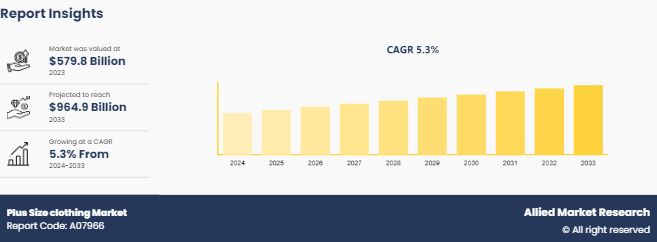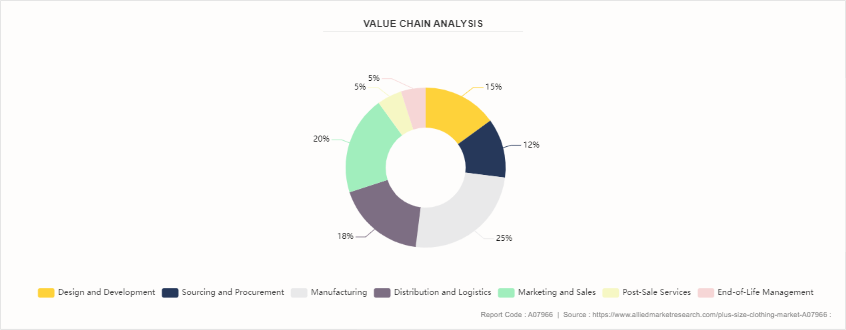Plus Size Clothing Market Research, 2033
Market Introduction and Definition
The global plus size clothing market was valued at $579.8 billion in 2023, and is projected to reach $964.9 billion by 2033, growing at a CAGR of 5.3% from 2024 to 2033.Plus size clothing refers to apparel designed specifically for individuals who wear sizes larger than the standard range. These garments, which include dresses, tops, pants, skirts, and outerwear, are tailored to provide a comfortable and flattering fit for fuller figures. Key characteristics of plus size clothing include proportional fit, comfortable fabrics, stylish designs, supportive features, and inclusive sizing. Modern plus size clothing emphasizes trendiness and fashion, catering to various personal styles while ensuring comfort and support through elements like wider straps and reinforced seams. The plus size clothing market strives to offer stylish, comfortable, and well-fitting options, promoting inclusivity and body positivity.

Key Takeaways
The plus size clothing market study covers 20 countries. The research includes a segment analysis of each country in terms of value ($Million) for the projected period 2023-2033.
More than 1, 500 product literatures, industry releases, annual reports, and other such documents of major clothing system industry participants along with authentic industry journals, trade associations' releases, and government websites have been reviewed for generating high-value industry insights.
The study integrated high-quality data, professional opinions and analysis, and critical independent perspectives. The research approach is intended to provide a balanced view of global markets and to assist stakeholders in making educated decisions in order to achieve their most ambitious growth objectives.
Key Market Dynamics
The increasing societal acceptance of diverse body types and the body positivity movement are significant drivers for the plus size clothing market. Consumers are demanding more inclusive fashion options that cater to all body shapes, which has led to brands expanding their size ranges and offering more stylish and flattering options for plus size individuals, increasing the Plus Size clothing Market Size.
The expansion of online shopping platforms has greatly contributed to the plus size clothing market. E-commerce allows for a broader reach and easier access to a variety of plus size clothing options that might not be available in physical stores. The convenience of online shopping, combined with features like virtual fitting rooms and detailed size guides, has enhanced the shopping experience for plus size consumers, increasing the Plus Size clothing Market Share.
Despite the growth of online shopping, many physical retail stores still offer a limited range of plus size clothing. This lack of in-store options can be a barrier for consumers who prefer to try on clothes before purchasing or who live in areas with fewer specialty stores, affecting the Plus Size clothing Market demand.
Producing plus size clothing often involves higher production costs due to the need for larger amounts of fabric and more complex design considerations. This can result in higher prices for plus size garments compared to standard sizes, which may deter some consumers from purchasing.
There is significant opportunity for growth in emerging markets where the plus size clothing market is still developing. As incomes rise and lifestyle changes increase the prevalence of larger body sizes in these regions, there is a growing demand for fashionable and affordable plus size clothing. Brands that enter these markets early can capitalize on this unmet need and establish a strong market presence.
Value chain of plus size clothing market
The value chain of the plus size clothing market involves several interconnected stages that collectively bring plus size garments from concept to consumer. It begins with design and development, where market research identifies consumer preferences and designers create and prototype garments tailored to plus size needs. Sourcing and procurement follow, involving the selection of appropriate materials and managing supplier relationships. In the manufacturing stage, patterns are adjusted for larger sizes, and garments are produced with a focus on quality control. Distribution and logistics manage the warehousing and transportation of finished products to retail or direct-to-consumer channels. Marketing and sales encompass branding efforts, retail operations, and e-commerce management, aiming to effectively reach and engage the plus size market. Post-sale services include collecting customer feedback and managing returns. Finally, end-of-life management focuses on sustainability practices, including recycling and disposal of unsold garments. Each stage is crucial for delivering high-quality, stylish plus size clothing while ensuring operational efficiency and customer satisfaction, increasing the Plus Size clothing Market growth.

Market Segmentation
The?plus size clothing market?is segmented on the basis of type, gender, age group, price point, and region. By type, the market is classified into casual wear, formal wear, sportswear, and others. On the basis of gender, it is bifurcated into male and female. According to age group, it is segregated into below 15, 16 to 59 and 60 & above. On the basis of price point, it is categorized into economy, mid-range, and premium. Region wise, the market is studied across North America, Europe, Asia-Pacific, and LAMEA.
Regional/Country Market Outlook
The U.S. Plus Size clothing Industry is expanding rapidly due to rising obesity rates, which affect nearly 42% of adults, and a strong push for body inclusivity. The growth of e-commerce has significantly increased access to plus size fashion, with technological advancements enhancing the shopping experience. According to the National Retail Federation, plus size clothing sales are growing, reflecting the increasing variety and availability in both online and physical stores.
China’s plus size clothing market has emerged in recent years. The factors driving growth include rising incomes, urbanization, and a shift in lifestyle habits leading to larger average body sizes. Despite a gradual acceptance of diverse body types, traditional preferences still influence the market. Research from Statista highlights a growing demand for plus size options, with both domestic and international brands increasing their offerings to meet consumer needs.
Industry Trends
There is a growing demand for inclusivity and body positivity in the fashion industry, leading to a significant expansion of the plus size clothing market. Brands and retailers are increasingly offering a wider range of sizes and styles to cater to diverse body types, driven by consumer demand for more representation and variety in fashion. This trend is supported by the rise of social media and body-positive movements, which advocate for greater acceptance of all body shapes and sizes. According to the U.S. Census Bureau, as of recent data, nearly 40% of American adults are classified as obese, which has driven the demand for plus size clothing. The Centers for Disease Control and Prevention (CDC) also reports similar trends, highlighting the growing need for larger size options in the clothing market.
The rise of e-commerce has greatly impacted the plus size clothing market, making it easier for consumers to access a broader range of plus size options. Online platforms offer more extensive size ranges and specialized plus size brands compared to traditional brick-and-mortar stores. This shift has been accelerated by improvements in online shopping technologies, such as virtual fitting rooms and size guides, enhancing the shopping experience for plus size consumers. Eurostat data indicates that approximately 50% of the adult population in EU countries are classified as overweight or obese. This demographic trend supports the expansion of the plus size clothing market across Europe, as brands and retailers adapt to meet the needs of a larger consumer base.
Competitive Landscape
The key players operating in the global plus size clothing market analysis include (H&M) Hennes & Mauritz AB, Ralph Lauren Corporation, Adidas AG (Adidas) , PUMA SE, Nike, Inc. (Nike) , ASOS plc, Capri Holdings Limited (Michael Kors) , WHP Global (Anne Klein) , Punto Fa SL (MANGO Inc.) , and Under Armour, Inc.?
Recent Key Strategies and Developments
In March 2023, the H & M expanded its plus size product offering along with the T
ess Holiday. The expansion will feature products in sizes up to 4XL for women and 3XL for men, rolling out across the country online and up to 2XL in store.
In November 2022, Adidas plus size wear collaborated with 11 Honore’s Plus Size. This is expected to focus on consumer need that doesn’t stop at traditional luxury fashion.
Key Benefits For Stakeholders
- This report provides a quantitative analysis of the market segments, current trends, estimations, and dynamics of the plus size clothing market analysis from 2024 to 2033 to identify the prevailing plus size clothing market opportunities.
- The market research is offered along with information related to key drivers, restraints, and opportunities.
- Porter's five forces analysis highlights the potency of buyers and suppliers to enable stakeholders make profit-oriented business decisions and strengthen their supplier-buyer network.
- In-depth analysis of the plus size clothing market segmentation assists to determine the prevailing market opportunities.
- Major countries in each region are mapped according to their revenue contribution to the global market.
- Market player positioning facilitates benchmarking and provides a clear understanding of the present position of the market players.
- The report includes the analysis of the regional as well as global plus size clothing market trends, key players, market segments, application areas, and market growth strategies.
Plus Size clothing Market Report Highlights
| Aspects | Details |
| Market Size By 2033 | USD 964.9 Billion |
| Growth Rate | CAGR of 5.3% |
| Forecast period | 2024 - 2033 |
| Report Pages | 265 |
| By Type |
|
| By Gender |
|
| By Age Group |
|
| By Price Point |
|
| By Region |
|
| Key Market Players | Ralph Lauren Corporation, Adidas AG (Adidas), Capri Holdings Limited (Michael Kors), (H&M) Hennes & Mauritz AB, Nike, Inc. (Nike), ASOS plc, PUMA SE, Under Armour Inc., WHP Global (Anne Klein), Punto Fa SL (MANGO Inc.) |
The global plus size clothing market was valued at $579.8 billion in 2023, and is projected to reach $964.9 billion by 2033, growing at a CAGR of 5.3% from 2024 to 2033.
The key players operating in the global plus size clothing market analysis include (H&M) Hennes & Mauritz AB, Ralph Lauren Corporation, Adidas AG (Adidas), PUMA SE, Nike, Inc. (Nike), ASOS plc, Capri Holdings Limited (Michael Kors), WHP Global (Anne Klein), Punto Fa SL (MANGO Inc.), and Under Armour, Inc.?
There's a growing emphasis on inclusivity, with brands expanding their size ranges and showcasing diversity in their marketing campaigns.
North America is the largest regnal market for Plus Size clothing
Casual Wear is the leading application of Plus Size clothing Market
Loading Table Of Content...



